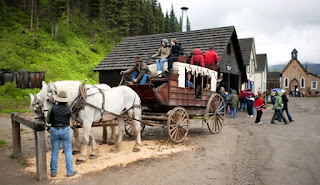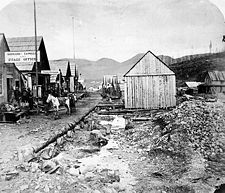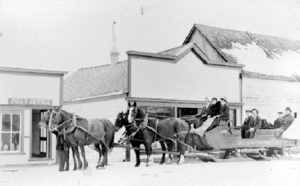Barnard's Express, later known as the
British Columbia Express
Company or
BX, was a pioneer transportation company that served the
Cariboo and
Fraser Fort
George regions in
British Columbia,
Canada from 1861 until 1921.
The company's beginnings date back to the peak of the
Cariboo Gold Rush
when hordes of adventurers were descending on the Cariboo region. There was a
great demand for transportation of passengers to and from the goldfields, as
well as the delivery of mining equipment, food supplies and mail between
Victoria and
Barkerville.

Barkerville has been restored and is now a great tourist attraction in the summer/warmer months.
The first express service offered on the
Cariboo Road was operated by
William
Ballou in 1858. Others soon followed, usually one or two man operations
where the proprietor himself packed the express goods, either on his back or
with the help of a trusty mule.
In 1863-64, additions like the use of
sleighs in the winter were used instead of wagons. The
year of 1864 saw the start of a 14 passenger four-horse stage. Later, with
increase of business, the stage was enlarged to a six-horse coach.

This was taken two blocks from where we are spending the winter in the village of Ashcroft.
It is now a private home.
In 1884, the bridge across from the
Fraser was opened, and trains came to
Lytton. Tingley made his final move to
Ashcroft and drove continuously
until 1897 when he sold the company to a group of Toronto lawyers headed by
Charles Vance
Millar. In 1903, Willis West became General Manager, a position he held
until the company demise in 1921.
The stages
The BC Express Company had a wide variety of stagecoaches. Some only required
two horses and were called a "jerky", while others were pulled by four or six
horses.

Some had closed-in carriages and others were open.

For winter travel,
the stagecoaches were replaced by sleighs of all sizes, including some that
could carry fifteen passengers. Many of the later stagecoaches were Concord
stages, built with shock absorbers made from leather springs which made for a
more comfortable ride.
I beg your pardon but I have ridden in them and it is very rough travelling.
In 1876, the company had a stagecoach built in California specifically for
the visit of the
Governor General,
Lord
and Lady Dufferin, who rode in it from Yale to
Kamloops and back. The coach was painted in the bright
red and yellow BX colours and had the Canadian
coat of arms on its front panels. It cost $50 a
day to ride in this famous coach, but many visiting diplomats and English
aristocracy rode in the Dufferin
when they went hunting in the Cariboo.

The horses
They leaped and reared at the start
of a trip, but

settled into a smooth trot once they were underway. The whip
rarely had to be used to encourage them, as they knew the next station meant a
good feed and a warm stable
.
The stations were approximately 18 miles apart and the teams were changed at
each one. The hostlers at the stations took pride in taking care of the
company's horses, often competing to see who kept the teams in the best
condition. One rule that was strictly followed was that each horse had its own
harness, which was cleaned every time it was taken off. To ensure that the
horses always had proper shoes, traveling horseshoers with portable
forges visited the stage stations
regularly.

BC Express stage at Clinton
An average trip from Yale to Barkerville can be broken down into sections.
The custom was at first to drive from Yale to
Spences Bridge (80
miles), the first day - six or seven miles an hour; then the next day from
Spence's Bridge to
Clinton (50 miles).
The best time ever made was by special conveyance from Yale to Barkerville.
The 380 miles from Yale to Barkerville was covered in 30 hours of continuous
driving. The usual stage time for the same distance was four days.
After the company's headquarters moved to Ashcoft in 1886, the main stageline
extended from Ascroft to Barkerville, a distance of 280 miles. Other branch
lines led to mining camps and settlements all over the Cariboo.
The strange thing is that it costs about the same today to take a Greyhound bus coach along the same route, but would only take about 8 hours on paved roads. However $60 in those days was worth a lot more than $60 now.
 Barkerville has been restored and is now a great tourist attraction in the summer/warmer months.
Barkerville has been restored and is now a great tourist attraction in the summer/warmer months. Some had closed-in carriages and others were open.
Some had closed-in carriages and others were open.  For winter travel,
the stagecoaches were replaced by sleighs of all sizes, including some that
could carry fifteen passengers. Many of the later stagecoaches were Concord
stages, built with shock absorbers made from leather springs which made for a
more comfortable ride. I beg your pardon but I have ridden in them and it is very rough travelling.
For winter travel,
the stagecoaches were replaced by sleighs of all sizes, including some that
could carry fifteen passengers. Many of the later stagecoaches were Concord
stages, built with shock absorbers made from leather springs which made for a
more comfortable ride. I beg your pardon but I have ridden in them and it is very rough travelling.














A very interesting post, Karyn! I love the history you share with us, and the photos enhance the share so much! It is so great when someone takes an old building and turns it into a residence, while preserving the historical footprint of the building. Travel times - amazing. Thanks, Karyn!!
ReplyDeleteI realized afterwards that I should have included a map to show where the first white pioneers travelled, usually first stopping at San Francisco and the Washington coast.
DeleteSimply delete his post(anonymous)... it will solve the problem and you can change the comment settings so only registered users could post.
ReplyDeleteOK I tried that and hope it works. Thank you.
DeleteYou are welcome and good luck to keep those away... hugs
ReplyDeleteFascinating. And now I know what a one horse open sleigh might look like.
ReplyDeleteGreat post. Reading (in between other things) for free on the Kobo: "Roughing it" by Mark Twain, about a journey West by stagecoach. It did not sound nearly as organized as the you describe. I never before realized fully that changing horses was the equivalent of gassing up the tank. We may end up back there.
ReplyDeleteThank you for providing stagecoach history in Clinton, B.C. My great grandfather was a stagecoach driver. In his latter years, this appeared in the
ReplyDeleteDeming Headlight 20 Sept 1895, Deming, New Mexico
Merriman-Harris. At the residence of John Lester, on Gold avenue, last Sunday afternoon at one o'clock, by Justice of the Peace, Louis l. Marshall, Mrs. Hattie E. Harris, of this city, was united in marriage to Charles Merriman, of CLINTON, BRITISH COLUMBIA. Only relatives and intimate friends of the contracting parties were present. After the ceremony the guests partake of an elegant wedding banquet at the residence of Mrs. S. Hopkins.
We know little about Charles Merriman and wish to know more.